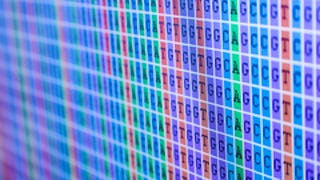In previous courses in the Specialization, we have discussed how to sequence and compare genomes. This course will cover advanced topics in finding mutations lurking within DNA and proteins.

Enjoy unlimited growth with a year of Coursera Plus for $199 (regularly $399). Save now.

Finding Mutations in DNA and Proteins (Bioinformatics VI)
This course is part of Bioinformatics Specialization


Instructors: Pavel Pevzner
17,013 already enrolled
Included with
(61 reviews)
Skills you'll gain
Details to know

Add to your LinkedIn profile
See how employees at top companies are mastering in-demand skills

Build your subject-matter expertise
- Learn new concepts from industry experts
- Gain a foundational understanding of a subject or tool
- Develop job-relevant skills with hands-on projects
- Earn a shareable career certificate

There are 6 modules in this course
<p>Welcome to our class! We are glad that you decided to join us.</p><p>In this class, we will consider the following two central biological questions (the computational approaches needed to solve them are shown in parentheses):</p><ol><li>How Do We Locate Disease-Causing Mutations? (<em>Combinatorial Pattern Matching</em>)</li><li>Why Have Biologists Still Not Developed an HIV Vaccine? (<em>Hidden Markov Models</em>)</li></ol><p>As in previous courses, each of these two chapters is accompanied by a Bioinformatics Cartoon created by talented artist Randall Christopher and serving as a chapter header in the Specialization's bestselling <a href="http://bioinformaticsalgorithms.com" target="_blank">print companion</a>. You can find the first chapter's cartoon at the bottom of this message. </p><p><img src="https://stepic.org/media/attachments/lessons/292/chapter7_cropped.jpg" title="Image: https://stepic.org/media/attachments/lessons/292/chapter7_cropped.jpg" width="528"></p>
What's included
4 videos2 readings1 assignment2 app items
<p>Welcome to week 2 of the class!</p> <p>This week, we will introduce a paradigm called the Burrows-Wheeler transform; after seeing how it can be used in string compression, we will demonstrate that it is also the foundation of modern read-mapping algorithms.</p>
What's included
3 videos1 reading2 app items
<p>Welcome to week 3 of class!</p> <p>Last week, we saw how the Burrows-Wheeler transform could be applied to multiple pattern matching. This week, we will speed up our algorithm and generalize it to the case that patterns have errors, which models the biological problem of mapping reads with errors to a reference genome.</p>
What's included
4 videos1 reading1 assignment2 app items
<p>Welcome to week 4 of class!</p> <p>This week, we will start examining the case of aligning sequences with many mutations -- such as related genes from different HIV strains -- and see that our problem formulation for sequence alignment is not adequate for highly diverged sequences.</p> <p>To improve our algorithms, we will introduce a machine-learning paradigm called a hidden Markov model and see how dynamic programming helps us answer questions about these models.</p>
What's included
5 videos2 app items
<p>Welcome to week 5 of class!</p> <p>Last week, we introduced hidden Markov models. This week, we will see how hidden Markov models can be applied to sequence alignment with a profile HMM. We will then consider some advanced topics in this area, which are related to advanced methods that we considered in a previous course for clustering.</p>
What's included
5 videos1 reading1 assignment2 app items
<p>Welcome to the sixth and final week of class!</p> <p>This week brings our Application Challenge, in which we apply the HMM sequence alignment algorithms that we have developed.</p>
What's included
1 peer review
Earn a career certificate
Add this credential to your LinkedIn profile, resume, or CV. Share it on social media and in your performance review.
Instructors


Offered by
Explore more from Health Informatics
 Status: Free Trial
Status: Free TrialUniversity of California San Diego
 Status: Free Trial
Status: Free TrialUniversity of California San Diego
 Status: Free Trial
Status: Free TrialUniversity of California San Diego
 Status: Free Trial
Status: Free TrialUniversity of Toronto
Why people choose Coursera for their career




Learner reviews
61 reviews
- 5 stars
70.49%
- 4 stars
24.59%
- 3 stars
3.27%
- 2 stars
1.63%
- 1 star
0%
Showing 3 of 61
Reviewed on Sep 15, 2018
Really enjoyed this course. It was great to get to build on work from previous courses.
Reviewed on Jul 31, 2021
Great course! It opened my mind on the capabilities of algorithms beyond its intended purpose.
Reviewed on Apr 13, 2020
It was probably my favorite in this specialization (at least, out of first six).
Frequently asked questions
To access the course materials, assignments and to earn a Certificate, you will need to purchase the Certificate experience when you enroll in a course. You can try a Free Trial instead, or apply for Financial Aid. The course may offer 'Full Course, No Certificate' instead. This option lets you see all course materials, submit required assessments, and get a final grade. This also means that you will not be able to purchase a Certificate experience.
When you enroll in the course, you get access to all of the courses in the Specialization, and you earn a certificate when you complete the work. Your electronic Certificate will be added to your Accomplishments page - from there, you can print your Certificate or add it to your LinkedIn profile.
Yes. In select learning programs, you can apply for financial aid or a scholarship if you can’t afford the enrollment fee. If fin aid or scholarship is available for your learning program selection, you’ll find a link to apply on the description page.
More questions
Financial aid available,
¹ Some assignments in this course are AI-graded. For these assignments, your data will be used in accordance with Coursera's Privacy Notice.





